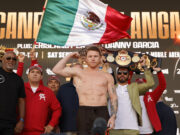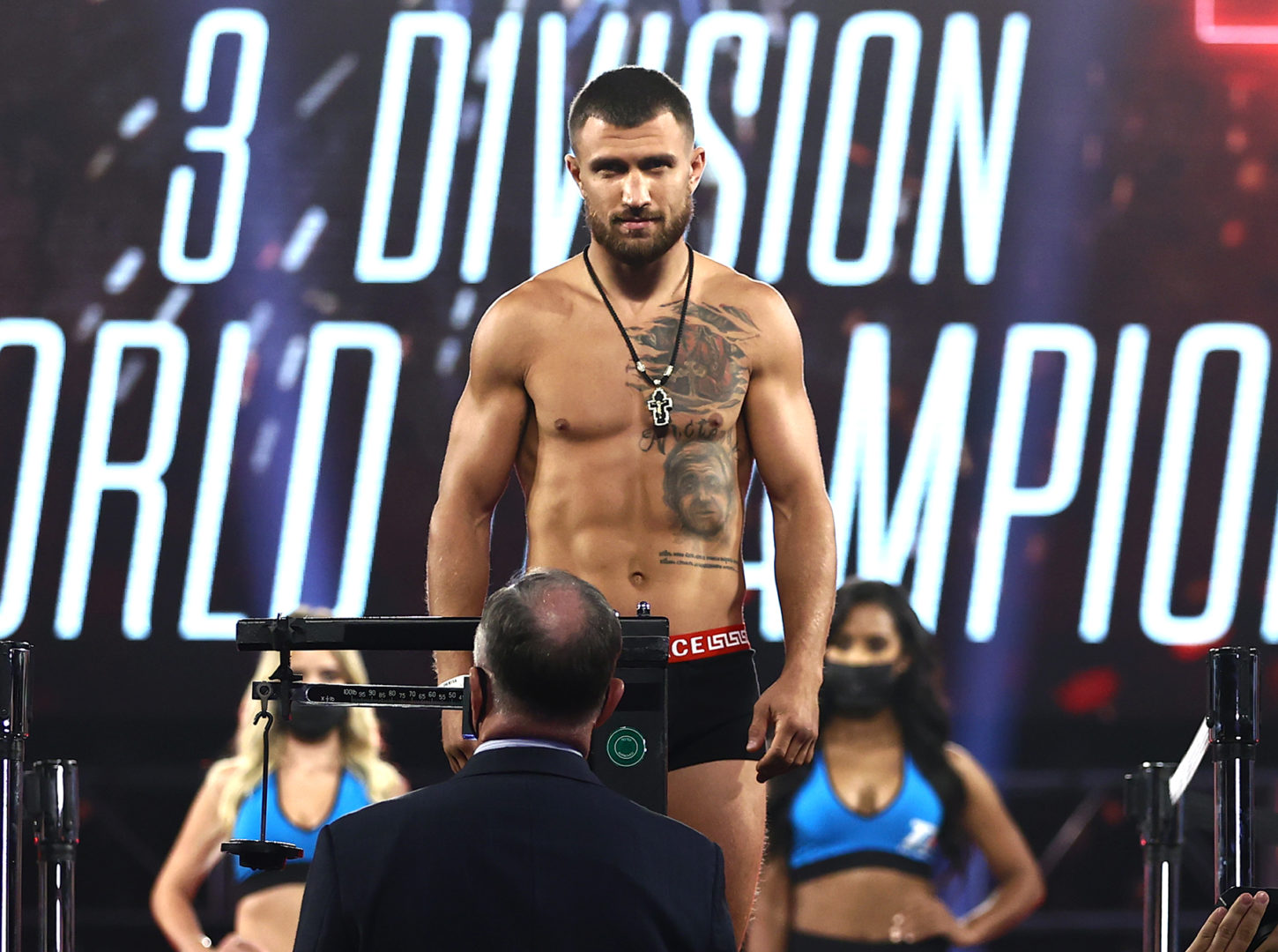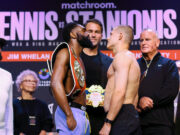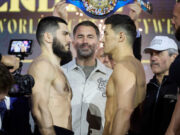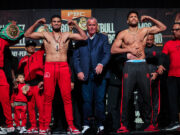By Bart Barry
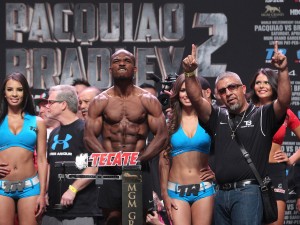
Saturday in a Thomas & Mack Arena that was not sold out, American welterweight Timothy “Desert Storm” Bradley and his new trainer, Teddy Atlas, combined to retire American Brandon “Bam Bam” Rios after dropping him twice, in round 9. The fight happened on HBO, a network that completed its three-year and 180-degree perspective-pivot on Bradley by celebrating Bradley’s new choice of trainer and Bradley’s new trainer with the enthusiasm of a rookie talent recruiter selling a prospect to Google.
Yes, the makeover is exaggerated, but let us play along for a couple reasons like: Tim’s a good guy, and we don’t have much of a choice because we’re going to be fed a Bradley-Atlas-union feast long after we push ourselves back from the table, hands waving in sated, otiose resistance.
If there’s a gigantic difference between the marketing of the Bradley-Atlas relationship and the Miguel Cotto-Freddie Roach relationship, it is not apparent. Both trainer narratives brought electrical charges to stalled products: Cotto, having been decisioned by Floyd Mayweather and Austin Trout, was out of the pay-per-view business unless something more than cosmetic might be done. A few more tattoos, a lot more hotpink, a goofy boy friend’s weightloss, an unknown handler from Cuba, improved English – these were insubstantial product improvements when set against knockout losses to Antonio Margarito and Manny Pacquiao and a two-fight losing streak. Enter Coach Freddie: what chemistry! what trust! what rediscovery of the left hook! my goodness!
Those enhancements, along with an opponent on the downside of a six-loss career, and the new and improved product was done with infomercials and ready to ship. Cotto then blazed through the tissuepaper of Sergio Martinez’s knee(s), became the linear middleweight champion of the world and perfected his pronunciation of an English phrase he learned early in ESL tutelage: “A-side.” (The ‘SL’ in ESL may be inaccurate, we now learn: the nurses in the Rhode Island hospital where apparently El Gran Campeón Puertorriqueño was born surely brought English to the young man’s ears early.) All the Cotto product relaunch lacked was a mandatory title defense against a hopeless opponent, a chance to remind viewers Cotto reminded them of anyone from Mike Tyson to Benny Leonard, old timers, in other words, who reminded us of the old Miguel Cotto – neither the guy who took a knee against Margarito nor the guy pulped by Pacquiao but the warrior who cracked Paulie Malignaggi’s face – and Daniel “Real Deal” Geale strode on the set in June.
That match brought the hundredth or so chance for viewers to squint for insights at a fight whose outcome not one aficionado doubted. Anymore, an engaged aficionado, an endangered mammal whose ranks continue thinning as its hungerstrikers perish from malnourishment, gets encouraged by broadcasters to watch fights the way an NFL scout investigates combines or a Major Leaguer stares at his radar gun. Since the matchmaking and broadcasting are universally ironic – in the rhetorical sense of meaning other than what they state – aficionados, uniquely endowed with the talent and opportunities for cynicism, cynically derive from results whatever they expect to see.
It would be tragic if it were not, in its way, an intriguing adaptation: As if lifelong basketball fans deprived of watching their favorite NBA teams play one another derived, instead, fantasy basketball teams assembled according to height and vertical leap and whatever glowing commentary Charles Barkley had about players, and then set these fantasy teams loose on high school playgrounds, where they regularly mauled their teenage opponents, leaving the financially interested broadcasters of these contests to say of LeBron James dunking over a 5-foot-3 schoolboy freshman, “Looking at that dominant performance by James, one immediately thinks of Dr. J in the 1983 finals against the Lakers!”
Would such a derivative league survive? Doubtlessly it would. Would it thrive? Doubtlessly it wouldn’t.
None of this describes, quite, what happened Saturday, so much as it describes what might happen in Bradley’s next match, which will not be against Canelo Alvarez, of all absurd suggestions. Bradley beat down Rios more effectively than anticipated. But here we go again: Was Bradley disproportionately improved, or was Rios, career property of promoter Top Rank and its peerless matchmaking, disproportionately spent before the bell?
A quick memory might be instructive. The first time I interviewed Bob Arum, in 2004, I asked him if Top Rank could select a prospect on one criterion alone, what that criterion would be.
“Does he dissipate between fights?” said Arum immediately.
Setting aside how much smarter that answer is than what Richard Schaefer or any of Al Haymon’s subsequent puppets might say, it underlines boldly how closely Top Rank considers its fighters between matches, which is a roundabout way of imparting how unsurprised Top Rank likely was by how helpless Brandon Rios looked Saturday. That is not an indictment of Timothy Bradley or his new trainer. It really isn’t. They prepared for a much larger version of the Brandon Rios who, in 2011, blitzed both Miguel Acosta and Urbano Antillon, surely, and Bradley did in fact look better.
It’s a partial indictment, though, of the silliness that happened during the telecast, the spiraling embellishment that seems modern broadcasting’s default reaction to the predictable unevenness of uneven contests. Couched in the false humility of the conditional tense – could it be? would it have been? were it possible . . . – the intended seeding of the idea finds its roots and caretaking in whatever follows the humblefeint, slipping right past the viewer’s lowered guard. It’s not meanspirited mischief, no, but neither is it disinterested.
Bart Barry can be reached via Twitter @bartbarry


